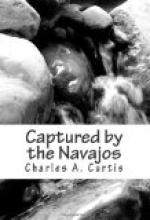Night overtook us on a high ridge covered with loose, rounded bowlders, over which it was necessary to lead the horses slowly, with considerable clatter and some bruises to man and beast. The rough road lasted until a considerable descent was made on the western side, and ended on the edge of a grassy valley.
At this point Weaver advised that the horses should be left and the command proceed on foot; for if the Indians were in camp at the rapids it would be impossible to approach mounted without alarming them, while if on foot the noise of the rushing water would cover the sound of all movements.
Six men were sent back to a narrow defile to prevent the attacking party from being surprised by the detachment of Indians which had taken the northern trail, should they intend to rejoin their friends at the rapids. Upon the recommendation of the scouts I determined to defer making an attack until after three o’clock, for they assured me that at that time the enemy would be feeling quite secure from pursuit and be in their deepest sleep.
The horses were picketed, guards posted, and a lunch distributed, and all not on duty lay down to wait. Time dragged slowly. About one o’clock a noise on the opposite side of the creek attracted attention, and Cooler crept away in the darkness to ascertain its cause. In half an hour he returned with the information that the party of Mezcalleros who had taken the northern trail had rejoined their friends and turned their animals into the general herd. Upon learning this I despatched a messenger to call in the six men sent to guard the defile.
When the time for starting arrived one man only was left with the picketed horses, and the rest of us slipped down the slope to the river-bottom, taking care not to rattle arms and equipments, and began a slow advance along a narrow pathway, the borders of which were lined with the spiked vegetation of the country.
Moving on for some time, I judged from the sound of flowing water that we were nearing the camp, and, halting the party, sent the scouts to reconnoitre. They returned with the information that the camp was close at hand, and contained thirteen mat and skin covered tents, or huts, and that the stolen stock and Indian ponies were grazing on a flat just beyond. No guards were visible.
The flat about the encampment was covered with Spanish-bayonet, soapweed, and cacti, with here and there a variety of palmetto, which attains a height of about twenty-five feet, the trunks shaggy with a fringe of dead spines left by each year’s growth. Cooler suggested that at a given signal the trunks of two of these trees should be set on fire to light up the camp, and enable the soldiers to pick off the Apaches as they left their shelter when our attack should begin. He also proposed that we yell, saying: “If you out-yell ’em, lieutenant, you can out-fight ’em.”
Although I seriously doubted whether twenty-five white throats could make as much noise as half a dozen red ones, I consented to the proposition. I sent nine men to the flat upon which the ponies and cattle were grazing, with orders to place themselves between the creek and herd, and when the firing began drive the animals into the hills.




